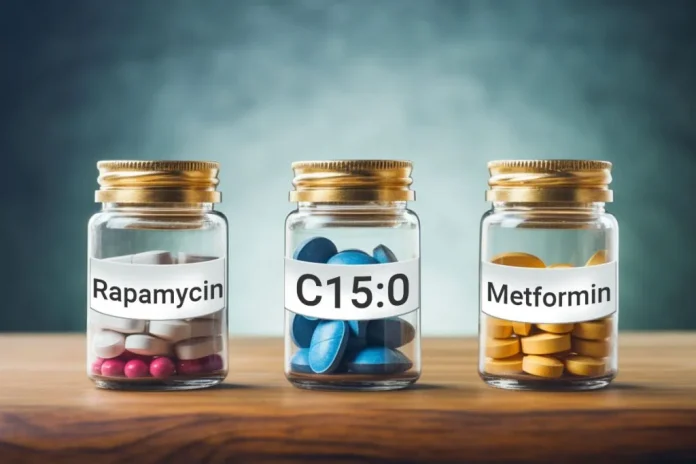New study explores the longevity potential of C15:0 and how it rivals other leading longevity-enhancing compounds.
In the quest for unlocking the secrets of longevity and healthy aging, a recent paper has delved into the remarkable properties of a seemingly ordinary fatty acid: C15:0. While decades of nutrition advice have warned us away from saturated fat, research into a newly-discovered fatty acid has turned that on its head.
An essential dietary fat, C15:0’s primary source is whole fat dairy – but fear not! Findings suggest that C15:0, a natural odd-chain fatty acid which is also found in some plants and fish, might be a key player in promoting longevity. What is particularly intriguing is how C15:0 stands shoulder to shoulder with renowned longevity-enhancing compounds like rapamycin and metformin.
Longevity.Technology: Rapamycin and metformin have been longevity’s poster boys for a few years, and both are the subjects of trials evaluating their effectiveness for longevity (PEARL and TAME, respectively). While C15:0 is a relatively new kid on the longevity block, it has already had its associations with health studied in global meta-analyses of large prospective cohort studies – studies that have taken place over decades, most of which included healthy individuals. It’s time to see more of C15:0.
Measuring up
The paper, by Stephanie Venn-Watson DVM, MPH, and Nicholas J Schork PhD, examines in detail the cellular and clinical activities of C15:0, drawing parallels with rapamycin, a well-established longevity-enhancing compound derived from bacteria found on Easter Island. Surprisingly, despite their disparate origins, C15:0 and rapamycin exhibit strikingly similar effects, especially in their optimal doses.
At their optimal doses, C15:0 and rapamycin showcase 24 shared, significant cell-based activities across 10 out of 12 cell systems. These include the suppression of key inflammatory markers (MCP-1, HLA-DR, VCAM-1) and anticancer activities, highlighting their potential in mitigating cardiovascular disease, chronic inflammation – inflammaging – and cancer.
The study, which was conducted using the BioMAP Diversity PLUS system, also draws parallels between C15:0 and metformin, a widely prescribed diabetes medication known for its potential antiaging effects [1]. C15:0 and metformin share 11 common, significant cell-based activities, including impacting on inflammatory mediators and targeting fibrotic processes. C15:0’s role in inflammation spotlights its potential application in preventing type 2 diabetes, as does its action as an AMP-activated protein kinase (AMPK) activator. AMPK is a central regulator of energy homeostasis, which coordinates metabolic pathways and therefore balances nutrient supply; this shared characteristic underlines the potential of C15:0 in metabolic regulation and its possible application in conditions like type 2 diabetes [2].
Longevity associations
The paper not only explores C15:0’s effect on cellular activities, but also delves into the extensive associations between circulating C15:0 concentrations and various health outcomes.
Cardiovascular health – higher C15:0 levels are linked to a lower risk of heart disease, including heart failure and myocardial infarctions.
Cancer protection – C15:0 demonstrates a strong antiproliferative effect on various cancer cell types, suggesting its potential role in cancer prevention and treatment.
Liver health – with the rising prevalence of nonalcoholic fatty liver disease (NAFLD), C15:0 emerges as a potential ally; it shows associations with lower liver fat and beneficial activities in primary human cell systems relevant to NAFLD.
Slows aging – studies indicate that C15:0 can effectively slow down the aging rate, as evidenced by improvements in hemoglobin levels, a biomarker of cellular fragility and aging.
Inhibits mTor – mTor drives senescence [3], whereas increased levels of mTOR stimulate autophagy [4] and are associated with Alzheimer’s [5].
Wider health impacts – from mitigating chronic obstructive pulmonary disease (COPD) to lowering cholesterol, C15:0 appears to be a versatile compound with far-reaching health benefits.
A compelling case
Venn-Watson and Schork make a compelling case for C15:0 to be considered a longevity molecule, offering robust evidence supporting its role in healthy aging and longevity. Its extensive cell-based activities, when compared with leading longevity-enhancing therapeutics, position C15:0 as a promising candidate for longevity therapeutics and supplements.
Given the declining levels of C15:0 in the population and its associations with various age-related conditions, there is an urgent need for further evaluation to understand and harness the potential benefits of this essential nutrient. The authors draw a striking link between global nutritional C15:0 deficiencies and a rise in chronic age-related conditions – perhaps addressing the former might reverse the latter?
The author’s view
Stephanie Venn-Watson, co-author on the study, is also cofounder and CEO of fatty15, a C15:0 dietary supplement.
We reached out to Venn-Watson to get her take on the research.

“Remarkedly, C15:0, a safe and natural nutrient, has many clinically relevant and longevity-enhancing activities that match and even outperform rapamycin,” she told us. “Our key to longevity now appears to be much closer to home than we once thought.”
With compelling evidence from both in vitro and in vivo studies, coupled with epidemiological support, C15:0 emerges as a strong candidate for promoting healthy aging and longevity in humans. The intriguing parallels with rapamycin and metformin, coupled with its associations with reduced risks of various age-related conditions, underscore C15:0 as a unique player in the longevity game – the race for longevity definitely has a fatty acid contender.


